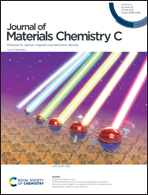Controllable binary/ternary memory behavior induced by isomerization of phenylhydrazone groups in polymer side chains under ultraviolet light conditions†
Abstract
Multi-factor collaborative regulation of memory device performance is an effective way to achieve multi-level data storage. In this paper, a photochromic methacrylate polymer with hydrazone structures in the side chains is elaborately designed as the active layer of a sandwiched device. The phenylhydrazone groups undergo reversible photo-induced cis–trans isomerization under alternating irradiation at 394 nm and 365 nm wavelengths, forming two isomers Ph1-Z and Ph1-E. The electrical device based on Ph1-Z realizes a change from the OFF state to ON1 state under electric field scanning, showing binary memory performance, but its configuration changes to Ph1-E under 394 nm ultraviolet light, and the device can be further turned on from the ON1 state to ON2 state. UV-vis, AFM, and XRD tests prove that the phenylhydrazone groups after UV irradiation undergo conformational change and the arrangement becomes orderly under an electric field, resulting in the improvement of its electrical conductivity. This discovery not only provides guidance for photoelectric combined regulation to realize a change in organic/polymeric material-based device conductivity, but also renders a new solution for updating the multi-level memory device.



 Please wait while we load your content...
Please wait while we load your content...